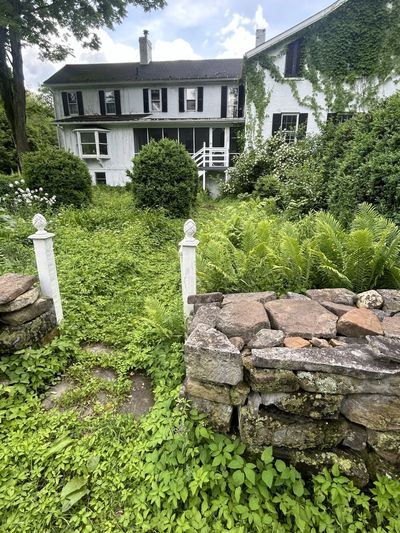About Colerain Forges Mansion

The History
The Environment
The Environment
Colerain Forges Mansion was built in the 1780s, with additions by the Ironmaster, David Stewart and his family in the 1830s through the 1860s. The estate includes the mansion and the stone house, built sometime in the 1760s, as well as 10 acres of historic formal gardens, including a boxwood maze, as well as woods and a significant stretch of beautiful Warriors Mark Run.

The Environment
The Environment
The Environment
Warriors Mark Run is a tributary of Spruce Creek, one of central Pennsylvania's premier trout fishing creeks. Our stretch of Warriors Mark Run has been virtually untouched for more than 30 years, preserving a healthy and diverse riparian ecosystem including several rare and endangered species of spring ephemerals. It was recently part of
Warriors Mark Run is a tributary of Spruce Creek, one of central Pennsylvania's premier trout fishing creeks. Our stretch of Warriors Mark Run has been virtually untouched for more than 30 years, preserving a healthy and diverse riparian ecosystem including several rare and endangered species of spring ephemerals. It was recently part of $800,000 grant to improve the entire watershed of the creek working with US Fish & Wildlife, Western PA Conservancy, Trout Unlimited and other partners and is classes as a Class A Wild Brown Trout habitat. If you love fishing please contact us about a possible fishing membership.
The grounds and gardens are available on a limited scale to rent by the day for events that fit within our mission, including history, the arts (including film and video projects), wellness, education, and horticulture.
We are hoping to start offering workshops soon on working with historic gardens and native plants in an environment free from chemical pesticides and herbicides.
The Gardens
The Gardens
The Gardens
The Historic Gardens at Colerain are undergoing constant renovations as we work to restore what was here and maintain what we've already preserved. Our latest project is reestablishing the 100 foot perennial border, the pride and joy of John Pekruhn whose family owned the estate from 1943 until 1988. Gardens need constant maintenance fo
The Historic Gardens at Colerain are undergoing constant renovations as we work to restore what was here and maintain what we've already preserved. Our latest project is reestablishing the 100 foot perennial border, the pride and joy of John Pekruhn whose family owned the estate from 1943 until 1988. Gardens need constant maintenance for watering and weeding to dividing perennials and planting annuals and bulbs. If you love gardening, consider becoming a volunteer.

The Arts
The Gardens
The Gardens
Colerain Forges Mansion has hosted musicians, actors and writers, providing a peaceful space that inspires creativity. The mansion has also served as a location for five films and a play. The Colerain Center sponsors an artist-in-residence program where writers, musicians, visual artists, and performers can come and stay in the mansion while working on specific projects.
Some History of Colerain Forges Mansion

Why "Colerain"?
By Dave Petit
A visitor from the last open house asked me why they decided to call the iron master’s mansion Colerain. The simplest answer is that the Stewarts, the family who lived in the mansion during its heyday as the hub of an iron-making community, were Scot-Irish and “Colerain” is a name from Northern Ireland. After giving it some thought, I decided to explore more of the backstory and see if there is a solid answer as to why the name Colerain was chosen.
Mr. Samuel Marshall Esq
By Dave Petit
There is a very deep, rich, early history to the Colerain property that I have researched and studied over the years to bring to the surface. One of the names of that earlier history is Samuel Marshall. The only evidence of his ownership of the Colerain property is the wooden section of the front of the mansion. Hopefully, in this brief biography of his life, I can shed some light on who he was.
Hidden in Plain Sight
By Dave Petit
This month's article covers the wooden front section of Colerain Forges Mansion that I briefly mentioned in the last article. I commented about how the wooden section belonged to Samuel Marshall, and would like to share the findings that led me to that conclusion.
Colerain's Iron
By Dave Petit
When you visit Colerain Forges Mansion, it can be hard to visualize it as the center of a busting iron industry. For almost 80 years, the area surrounding the mansion was a loud, smoke-filled, and busy hub of an ironmaking community.
The Forge
By Dave Petit
During some recent tours of Colerain Forges Mansion a few visitors asked me, “Where did the furnace sit?” The short answer to this question is that Colerain Forges did not have a furnace; it had forges. With this in mind, I thought I would take a few moments and write a few lines explaining what a forge is.
Calendar of Events
Dates and details are subject to change until tickets are for sale.
The Ruta Beggars: Taking My Time
The Ruta Beggars filmed this great video during their residency at Colerain Forges Mansion in May 2024.
Check it out!

Lend a Hand: Volunteers Welcome
Volunteer opportunities include helping with events, building trails, removing invasive plants, and restoring gardens. We are also working on the new meditation garden as well identifying archaeological sites for future research.
Thank You
Whether you help through becoming a member, giving a donation, volunteering your time, or spreading our mission through word-of-mouth, thank you. We couldn't accomplish our goals without the help of supporters like you.
The Colerain Center for Education, Preservation, and the Arts is a 501(c)(3) nonprofit organization, started in 2019 with the mission of sharing this federally recognized National Register of Historic Places site with the greater community.
The Colerain Center at Colerain Forges Mansion
4072 Spruce Creek Road, Spruce Creek, PA 16683
